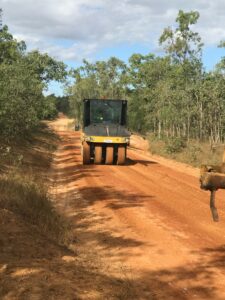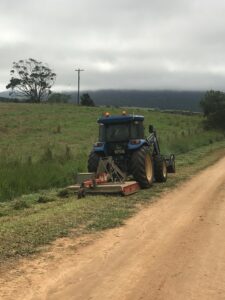We conduct regular routine inspections on our local network and investigate problems and requests reported by the community. The routine inspections are conducted by our road stewards who drive and walk the assigned inspection routes. The stewards identify, measure and record defects in accordance with our intervention levels. These defects are then recorded in our asset management system. This provides a measure of the condition of each road, which can be used to establish our routine maintenance and capital work requirements. Through the collation of defect data, programs are then created with consideration of risk, road hierarchy and resources.
Find out more from our Roads Maintenance Management Plan.
We regularly sweep all bitumen roads with a kerb across the region.
Pothole and road edge repairs are conducted year round on our sealed roads. Repairs are prioritised according to a defect score that takes into consideration position and visibility of the defect, and then compared to star rating of the road. This systematic approach ensures higher risk defects are prioritised first.
Road surface repairs involve the removal and replacement of the affected area. The sections of road are prepared around the middle of each year so they are ready for the annual bitumen reseal and asphalt overlay programs.
See the latest information on work on sealed roads on our project and program updates page.
Grading is the process of restoring the driving surface of a gravel or natural surface road to a desired smoothness and shape by removing irregularities, such as corrugations and potholes, and redistributing gravel. We typically remove these irregularities by cutting the surface of the road or filling them with material moved back and forth across the road with the grader.
Roads are inspected for defects and only graded if defects meet intervention levels. Factors that contribute to the assessment include the size, depth and number of defects, location on road, length of road, traffic types, traffic flow, etc. If defects are constantly appearing/meeting intervention levels on a particular gravel road, a recommendation is made to have the road resheeted (new layer of road base/gravel) as part of the following financial year’s capital works program.
Grading is generally conducted from April/May until the wet season.
Throughout the year we conduct minor repairs to unsealed roads as needed. This includes filling potholes and wheel ruts with gravel. In November and December we lightly grade the edges of rural roads to remove vegetation and ensure sufficient drainage.
See the latest information on work on unsealed roads on our project and program updates page.

Several teams of slashers maintain our rural road edges. Slashing is conducted for most of the year but may be ceased in some areas if dry conditions raise the fire danger. Side-arm slashing is conducted in June and July each year.
See what roads are being slashed this month on our project and program updates page.

We conduct roadside herbicide spraying during optimal weather between April and June each year. The spray reduces vegetation encroachment around culverts and drains to ensure sufficient drainage.
We also have a contract with Department of Transport and Main Roads to spot spray certain weeds along Main Roads. This occurs at optimal times of the year.
Debris and silt are cleaned from earth and concrete surface drains, culverts, pipes and pits between August and October each year. Chipped, cracked and misaligned kerbs are repaired during August and September.
See if any kerbs and drains are being maintained this month on our project and program updates page.
Signs, posts and guide posts are cleaned, repaired, replaced and installed primarily during the wet season.

